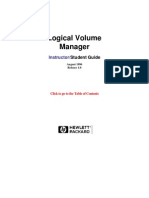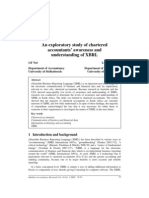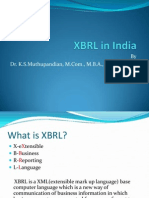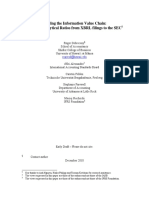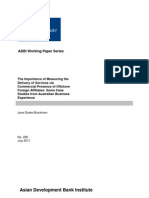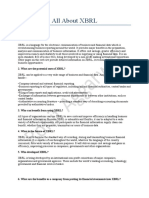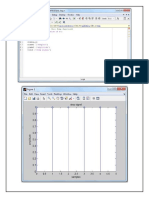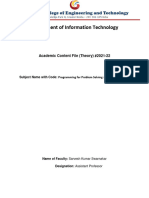Reading 6.1
Reading 6.1
Uploaded by
Tho LuCopyright:
Available Formats
Reading 6.1
Reading 6.1
Uploaded by
Tho LuCopyright
Available Formats
Share this document
Did you find this document useful?
Is this content inappropriate?
Copyright:
Available Formats
Reading 6.1
Reading 6.1
Uploaded by
Tho LuCopyright:
Available Formats
CONTEMPORARY BUSINESS ISSUES
R E A D I N G 6.1
Reading 6.1
Standard business reporting using XBRL
Introduction
eXtensible Business Reporting Language (XBRL) is a Web programming language from the XMLfamily of languages. (XML is discussed in The ICT environment for business under the heading Networking technologies.) It is the outcome of the DutchTaxonomy Project (Nederlandse Taxonomie Project or NTP), which began in 2004 as part of the Dutch Governments objectives to reduce the administrative burdens on businesses. The NTP createdthe XBRL taxonomy to enable businesses to generate the required reporting informationdirectly from their own records, and for government to be able to process this informationefficiently andeffectively. In 2006, the Australian Government adopted the Dutch approach and established theStandard Business Reporting (SBR) program. This program is expected to save Australian business an estimated $800 million per year once fully implemented (TheTreasury 2011). Besides Australia, many other countries are now applying this approach which has sincebeen internationally referred to as Standard Business Reporting. XBRL has evolved as the major vehicle for SBR and is often viewed as a global effort by participants of thebusiness reporting supply chain to build the digital language of business.
Features of XBRL
The two basic features of an effective information management system are to provide meaningful information to management and other relevant stakeholders, and to help management satisfy regulatory reporting obligations, particularly those of tax administration authorities. XBRL achieves these two important objectives in a costeffective way. Richards and Tibbits (2002, p. 3) stressed that XBRL is about improving the reporting of accounting standards in all countries (Richards & Tibbits 2002, p. 3) and enabling organisations to adapt to changing standards.
R E A D I N G 6.1
CONTEMPORARY BUSINESS ISSUES
Richards and Tibbits (2002) identified a number of concerns with the way that financial reporting is traditionally conducted and how XBRL might mitigate these concerns: n Often business enterprises are required to report similar information in different formats to various stakeholders. XBRL can help to generate the information once and make it easy topresent it in different ways electronically. n Frequently, data available to stakeholders is outdated, and finding information about the organisation may be even harder. Furthermore, users often find it difficult to locate the information they need and even when the information is found there may be issues with the way the information is formatted. AnXBRL search engine can locate information from multiple web sites or sources and immediately transfer it into a spreadsheet. Moreover, because an XBRL search engine searches for narrowly defined content and delivers it to oneplace, itautomatically conducts a directive search for information on behalf of the user,rather than forcing the user to view information sequentially. n There are considerable difficulties for information users in understanding different formats entities use to report information (e.g. word-processed/spreadsheet/pdf documents and HTML pages). An XBRL search engine can locate information from multiple web sites or sources in different formats and transform this information into an easily-understood spreadsheet. n If users want to analyse data, they often need to re-enter data into their own systems, whichcan cause transfer errors. XBRL automatically transforms data from multiple web sites and in different formats into a spreadsheet. Consequently, thereis no need to re-enter data, and there is less likelihood of transcription errors.
The advantages of Standard Business Reporting
A study by Kennedy and Hodge (2002) found that XBRL can improve the transparency of financial statements. They noted that users of financial statements tended to give more significance to information disclosed in the body of a financial statement and less significance to information in the notes, thus tempting some organisations to hide negative information in the notes. When financial statements are presented in a non-searchable format, such as a [scanned] pdf file, [readers] may fail to recognise relationships between data; or overlook disclosed items completely (Kennedy & Hodge 2002, p. 38). However, with XBRLs searchable format, users are able to view related and disclosed information simultaneously and eliminate the preference givento one piece of information over the other. XBRL can potentially make the disclosure of information more transparent by enhancing searches and facilitating integration andcomparison of information (Kennedy & Hodge 2002, p. 38). Figure 1 shows the business reporting supply chain. The processes start with business operations, then financial information is recorded and reported to internal and external users foranalysis. Stakeholders in the business reporting supply chain (such as the enterprise preparing the data, investors, trading partners, auditors, etc.) would benefit from the creation ofdigital versions of financial information using a common standard, as offered by XBRL.
CONTEMPORARY BUSINESS ISSUES
R E A D I N G 6.1
Figure 1: The business reporting supply chain
Business Operations Internal Financial Reporting External Financial Reporting Financial Publishers and Data Aggregators Auditors Software Suppliers
Source: Richards, J. & Tibbits, H. (2002), Understanding XBRL, CPA Australia NSW Branch Workshop, <http://www.xbrl.org.au/training/NSWWorkshop.pdf> (accessed May 2011), p. 5.
Processes
Investment and Lending Analysis
Participants
Business Enterprises
Investors
Trading Partners
Management Accountants
Regulators
Figure 2 shows that the reporting supply chain has many information sources. Themajor source is the accounting system. However, the report supply chain also has many different types of reports that are distributed to various stakeholders. Reportsgenerated within this environment are typically from a diverse range of operating systems that need additional manipulation or redesign to enable them to be shared amongst various users. XBRL can act as an intermediary to lessen this complex information exchange process, especially for entities that have many business partners, leading to considerable time and cost savings.
Figure 2: Multiple outputs from a single specification and information flow to stakeholders
Information Source Accounting system XBRL Other Sources of Information Information Outputs Printed Financials Regulatory Filings Web Site Tax Returns Bank Filings Stakeholders Investors XBRL Other Parties
Source: Compiled from Richards, J. & Tibbits, H. (2002), Understanding XBRL, CPA Australia NSW Branch Workshop, pp. 6 and 7, <http://www.xbrl.org.au/training/NSWWorkshop.pdf> (accessedMay2011).
R E A D I N G 6.1
CONTEMPORARY BUSINESS ISSUES
It is not the intention of this section to examine the technical details of XBRL. It will instead show how the use of XBRL can lead to substantial savings for enterprises, irrespective of their size. Figure 3 illustrates that XBRL may be used throughout the business reporting supply chain process in areas such as: n business event and general ledger reporting, and n preparing audit schedules, regulatory compliance filings or lodgements, financialstatements and tax filings.
Figure 3: XBRL and the business reporting supply chain
XBRL for Regulatory Filings (including APRA)
XBRL for General Ledger Reporting
XBRL for Financial Statements External Financial Reporting Investment and Lending Analysis
Processes
Business Operations
Internal Financial Reporting
XBRL for Business Event Reporting
XBRL for Audit Schedules
XBRL for Tax Filings
(Australian Prudential Regulator Authority (APRA) is the Australian regulator of banks, insurance companies and other financial institutions.)
Source: Adapted from Richards, J. & Tibbits, H. (2002), Understanding XBRL, CPA Australia NSW Branch Workshop, p.9, <http://www.xbrl.org.au/training/NSWWorkshop.pdf> (accessed May 2011).
By using XBRL for their standard business reporting, the Dutch Government has been able to reduce the number of data items requested from Dutch businesses by all its agencies from 180000 to 4500 with an estimated annual saving across the Netherlands economy of 750million. XBRL Australia Ltd (Pyman 2006, p. 2) argues that: XBRL will not help where there is duplicated regulatory oversight but it will assist where there is duplicate reporting requirements, by enabling the automation of reporting so that the burden on the preparer is reduced, either by eliminating the duplication for business if the data can be received byone agency and shared with others via a common data format; or making the duplicate reporting a trivial exercise (Pyman 2006, p. 2). A standardised business reporting format based on XBRL can help to reduce the regulatory burden on business in the following ways by: n encouraging system providers to implement the same reporting standard. n permitting relevant regulatory bodies to access audited financial statements inthesameformat. n promoting the free flow of information between business and government. n enabling the collection of data to be explicit and handled directly between computers atallpoints in the business reporting supply chain. n eliminating the need for special interfaces or special software to read the information which would reduce the risk of human error and increase data reliability (Pyman 2006, pp. 23).
CONTEMPORARY BUSINESS ISSUES
R E A D I N G 6.1
As with all new technology, XBRL does have some drawbacks. First, some organisations may experience high start-up costs for implementing the system, particularly those that do not have the latest technology or Web presence. Second, the availability and ease of access to financial information through XBRL may pose a security risk related to the amendment of sensitive information without authorisation and its disclosure to people outside the organisation. Third, having information that is accessible at any time means that there is a greater need forittobe accurate at all times, otherwise it could prove to be misleading and expose the organisation to court action. However, observers generally agree that the advantages of XBRL far outweigh the disadvantages. Moreover, the greater the number of regulatory bodies and government agenciesthat adopt an XBRL-based common reporting standard, the more likely it will be thatbusiness enterprises will do the same, resulting in more timely and automated businessreporting. A range of supporting information and resources is available from the Australian Government Treasurys web site at <http://www.sbr.gov.au/> (accessed May 2011).
References
Kennedy, J. & Hodge, F. (2002) Will a new technology give financial analysts x-ray vision? UW Business, Fall, pp. 389 <http://www.foster.washington.edu/about/Documents/Foster%20Business%20Archives/ Fall%2002/Faculty_Research.pdf> (accessed May 2011). Pyman, T. (2006) Reducing the regulatory burden on business <http://www.xbrl.org.au/news/documents/Regulation%20Taskforce%20Submission%20 XBRL.pdf> (accessed May 2011). Richards, J. & Tibbits, H. (2002) Understanding XBRL CPA Australia NSW Branch Workshop <http://www.xbrl.org.au/training/NSWWorkshop.pdf> (accessed May 2011). The Treasury (2010) About SBR <https://www.sbr.gov.au/content/public/about> (accessed May 2011).
You might also like
- 2023 LLMBC App in HourDocument39 pages2023 LLMBC App in HourAbhishek DasNo ratings yet
- STP 9000Document4 pagesSTP 9000Ray BannyNo ratings yet
- HPUX LVM StudentGuideDocument118 pagesHPUX LVM StudentGuidehjsnelNo ratings yet
- T&T PresentationDocument17 pagesT&T PresentationMohammed HussainNo ratings yet
- Study On XBRL Implementation For Financial Reporting.Document41 pagesStudy On XBRL Implementation For Financial Reporting.sa281289100% (1)
- XBRLDocument36 pagesXBRLRishu TandonNo ratings yet
- The Impact of XBRL On Financial Reporting: A Conceptual AnalysisDocument8 pagesThe Impact of XBRL On Financial Reporting: A Conceptual AnalysisChima EmmanuelNo ratings yet
- What Is XBRLDocument3 pagesWhat Is XBRLpawan kumar dubeyNo ratings yet
- Effectiveness XBRLDocument4 pagesEffectiveness XBRLMirul SafwanNo ratings yet
- Kloos et al. - 2014 - XBRL-driven business process improvement A simulation study in the accounting domainDocument15 pagesKloos et al. - 2014 - XBRL-driven business process improvement A simulation study in the accounting domainbelajarlagi59No ratings yet
- B 3 XBRLDocument17 pagesB 3 XBRLKhushi DNo ratings yet
- Nel & Steenkamp (7.08) - Meditari Vol 16 No 1 2008Document15 pagesNel & Steenkamp (7.08) - Meditari Vol 16 No 1 2008Essam AminNo ratings yet
- 0905 XBRLDocument2 pages0905 XBRLshrikantgarudNo ratings yet
- Faqs On XBRLDocument5 pagesFaqs On XBRLDarshan ShahNo ratings yet
- Class of Companies: WWW - Mca.gov - inDocument5 pagesClass of Companies: WWW - Mca.gov - inParvathalu NeelaNo ratings yet
- XBRL in IndiaDocument23 pagesXBRL in Indiaksmuthupandian2098No ratings yet
- Application of Extensible BusinessDocument9 pagesApplication of Extensible BusinessJabed MansuriNo ratings yet
- XBRL FaqDocument6 pagesXBRL FaqaauchityaNo ratings yet
- Critical Reflection On XBRLDocument23 pagesCritical Reflection On XBRLSudershan ThaibaNo ratings yet
- Does Integrated Reporting Matter To The CapitalDocument40 pagesDoes Integrated Reporting Matter To The CapitalZahraNo ratings yet
- XBRL: Enabling Faster, More Transparent Financial ReportingDocument12 pagesXBRL: Enabling Faster, More Transparent Financial ReportingPrasad VeeraNo ratings yet
- MCA Circular - 31.3.2011Document8 pagesMCA Circular - 31.3.2011Karishma ThakkarNo ratings yet
- XBRL and AccaDocument76 pagesXBRL and AccaValentin BurcaNo ratings yet
- Hot Topic: XBRL-A New Era in The Delivery of Financial Information?Document5 pagesHot Topic: XBRL-A New Era in The Delivery of Financial Information?urkerNo ratings yet
- XBRL - A Global Fi Nancial Reporting Standard: ThemeDocument7 pagesXBRL - A Global Fi Nancial Reporting Standard: Themeksmuthupandian2098No ratings yet
- C15. XBRL New ToolDocument20 pagesC15. XBRL New ToolHayderAlTamimiNo ratings yet
- XBRL Reference GuideDocument86 pagesXBRL Reference GuideAri Tata AdiantaNo ratings yet
- Boritz and No 2008 ABS 2 XBRL AuditingDocument16 pagesBoritz and No 2008 ABS 2 XBRL AuditingEsraa S AlkhatibNo ratings yet
- Financial Accounting - Accounting TheoryDocument62 pagesFinancial Accounting - Accounting TheoryKagaba Jean BoscoNo ratings yet
- Final Report EPR Doing BusinessDocument84 pagesFinal Report EPR Doing BusinessAzhari Novy SuciptoNo ratings yet
- M119. Big Data and Algorithmic Trading Against Periodic and Tangibleasset ReportingDocument16 pagesM119. Big Data and Algorithmic Trading Against Periodic and Tangibleasset ReportingMirela BrasilNo ratings yet
- 2 Debreceny XBRL Ratios 20101213Document31 pages2 Debreceny XBRL Ratios 20101213Ardi PrawiroNo ratings yet
- Assignment On XBRLDocument11 pagesAssignment On XBRLArijit B Chowdhury100% (1)
- XBRL in The New Call Reporting ProcessDocument26 pagesXBRL in The New Call Reporting ProcessPuneet SinghNo ratings yet
- ADBI Working Paper Series: Asian Development Bank InstituteDocument37 pagesADBI Working Paper Series: Asian Development Bank InstituteADBI PublicationsNo ratings yet
- Big Data Analytics in Financial Reporting and AccountingDocument4 pagesBig Data Analytics in Financial Reporting and Accountingمعن الفاعوريNo ratings yet
- 2015 T. Besley - Law, Regulation, and The Business Climate The Nature and Influence of The World Bank Doing Business ProjectDocument26 pages2015 T. Besley - Law, Regulation, and The Business Climate The Nature and Influence of The World Bank Doing Business ProjecttriplewhitepjNo ratings yet
- 11 12 13 15Document8 pages11 12 13 15Vanilla GirlNo ratings yet
- Business Model Version 1Document23 pagesBusiness Model Version 1ManivannancNo ratings yet
- No 2Document2 pagesNo 2Nata MagieNo ratings yet
- Csit5 13501416 PDFDocument10 pagesCsit5 13501416 PDFHayderAlTamimiNo ratings yet
- Financial Reporting and Management Reporting SystemsDocument71 pagesFinancial Reporting and Management Reporting SystemscamsNo ratings yet
- XBRL TechnologyDocument2 pagesXBRL TechnologyCris R. HatterNo ratings yet
- Law, Regulation, and The Business Climate: The Nature and Influence of The World Bank Doing Business ProjectDocument24 pagesLaw, Regulation, and The Business Climate: The Nature and Influence of The World Bank Doing Business ProjectCesar Mercado RicoNo ratings yet
- A Dimensional Data Model For Healthcare Revenue Cycle Analytics and Business Intelligence Joseph George A1Document6 pagesA Dimensional Data Model For Healthcare Revenue Cycle Analytics and Business Intelligence Joseph George A1Harsh WaghelaNo ratings yet
- Article 2 PDFDocument4 pagesArticle 2 PDFAllan CintronNo ratings yet
- CA XBRL Preparers GuideDocument98 pagesCA XBRL Preparers GuideGaurav RamrakhyaNo ratings yet
- Understanding Regtech For Digital Regulatory Compliance: Tom Butler and Leona O'BrienDocument18 pagesUnderstanding Regtech For Digital Regulatory Compliance: Tom Butler and Leona O'BrienjNo ratings yet
- Aeb1 11801196 PDFDocument8 pagesAeb1 11801196 PDFHayderAlTamimiNo ratings yet
- Chapter22222 OuttDocument14 pagesChapter22222 OuttAmrran AbdiNo ratings yet
- XBRLDocument33 pagesXBRLShi SyngeNo ratings yet
- Audit1a Summary CAA & XBRLDocument2 pagesAudit1a Summary CAA & XBRLVenz Karylle CapitanNo ratings yet
- Applying Multiple Linear Regression and Neural Network To Predict Business Performance Using The Reliability of Accounting Information SystemDocument15 pagesApplying Multiple Linear Regression and Neural Network To Predict Business Performance Using The Reliability of Accounting Information SystemSbm OdexNo ratings yet
- Managing It Innovation Recessionary and Post-Recessionary Service and Staffing ModelsDocument8 pagesManaging It Innovation Recessionary and Post-Recessionary Service and Staffing ModelsijmitNo ratings yet
- 10399Document29 pages10399ranyaveeckmhNo ratings yet
- No.2 FullDocument24 pagesNo.2 FullNata MagieNo ratings yet
- Do Firms Use The Database Accounting Approach in The Design of Their AIS?Document24 pagesDo Firms Use The Database Accounting Approach in The Design of Their AIS?simcity23No ratings yet
- Visualising Business Data. A SurveyDocument54 pagesVisualising Business Data. A SurveyFernando Torres SanchoNo ratings yet
- Fras Ace It Uno 2013Document11 pagesFras Ace It Uno 2013zedlibraryNo ratings yet
- Harsh Acc InfoDocument25 pagesHarsh Acc InfoGurleen KaurNo ratings yet
- All About XBRL: 2. What Are The Potential Uses of XBRL?Document9 pagesAll About XBRL: 2. What Are The Potential Uses of XBRL?Rohit AggarwalNo ratings yet
- Data Governance for Tax Administrations: A Practical GuideFrom EverandData Governance for Tax Administrations: A Practical GuideNo ratings yet
- Building and Operating Data Hubs: Using a practical Framework as ToolsetFrom EverandBuilding and Operating Data Hubs: Using a practical Framework as ToolsetNo ratings yet
- Netweaver Gateway T Code SummaryDocument8 pagesNetweaver Gateway T Code SummaryPraveen KumarNo ratings yet
- External CfA 11-2017Document2 pagesExternal CfA 11-2017Studio Hapsira sh.p.kNo ratings yet
- DictionaryDocument2 pagesDictionarydchavan0853No ratings yet
- Lab File - Digital Signal Processing Using MATLABDocument32 pagesLab File - Digital Signal Processing Using MATLABCutie100% (2)
- Enrollment-Analyn-Individual-Workweek-Accomplishment-Report June 15-19 2020Document2 pagesEnrollment-Analyn-Individual-Workweek-Accomplishment-Report June 15-19 2020Analyn Lyzzaine Pradela100% (1)
- AquaTROLL 100 200 ManualDocument94 pagesAquaTROLL 100 200 ManualBerry CasanovaNo ratings yet
- III Sem Yoga Mandatory courseDocument5 pagesIII Sem Yoga Mandatory courseVaradaNo ratings yet
- Eres Wincc v13 enDocument23 pagesEres Wincc v13 enFernando Jaime Alonso MartínezNo ratings yet
- Class XiiDocument6 pagesClass Xiikunalsinghchouhan7714No ratings yet
- Iijcs 2014 11 17 28Document5 pagesIijcs 2014 11 17 28International Journal of Application or Innovation in Engineering & ManagementNo ratings yet
- OssecDocument23 pagesOssecSoumya RoutNo ratings yet
- LTE PRACH Preamble FormatDocument12 pagesLTE PRACH Preamble FormatBiswajit MohantyNo ratings yet
- 1KHW000890-En Operating Instructions NSD570 (Dec 2009, Updated May 2010)Document552 pages1KHW000890-En Operating Instructions NSD570 (Dec 2009, Updated May 2010)lazaruz100% (3)
- Rdo, Ado & Tdo in OrposDocument23 pagesRdo, Ado & Tdo in OrposTanuj KathuriaNo ratings yet
- Apple Distribution StrategyDocument4 pagesApple Distribution StrategyEka Darmadi100% (1)
- En ACH580 HVAC Control Program FW C A5 ScreenDocument492 pagesEn ACH580 HVAC Control Program FW C A5 ScreenCH AsiaNo ratings yet
- Course 1 - Introduction To HMI-part1Document13 pagesCourse 1 - Introduction To HMI-part1Mo NimNo ratings yet
- Biometric Integration - User Manual: Created By, Smit Thakur, QA Team 08-05-2019Document8 pagesBiometric Integration - User Manual: Created By, Smit Thakur, QA Team 08-05-2019ksuresh0055599No ratings yet
- CS411 Grand Quiz by JunaidDocument25 pagesCS411 Grand Quiz by JunaidInformation everything50% (4)
- 6 KCS101T 201T Prog For Prob SolvingDocument215 pages6 KCS101T 201T Prog For Prob SolvingRakesh SharmaNo ratings yet
- How To Win A CTF CompetitionDocument10 pagesHow To Win A CTF CompetitionRadu MarinNo ratings yet
- Vfe Out-Band DCN MopDocument34 pagesVfe Out-Band DCN Mopmohamed abdel karimNo ratings yet
- Hardware Manual Update SDCS-COM-8 DCS800 Drives (20 To 5200 A)Document8 pagesHardware Manual Update SDCS-COM-8 DCS800 Drives (20 To 5200 A)Alan Mendoza FloresNo ratings yet
- Nec Versa Txi Series Notebook Computers: Service ManualDocument97 pagesNec Versa Txi Series Notebook Computers: Service ManualburdilesNo ratings yet
- Why Azure Consulting Is Key To Accelerating Your Cloud TransformationDocument12 pagesWhy Azure Consulting Is Key To Accelerating Your Cloud TransformationAnsibytecode LLPNo ratings yet
- UA5000 Technical ManualDocument161 pagesUA5000 Technical ManualhahyyNo ratings yet



